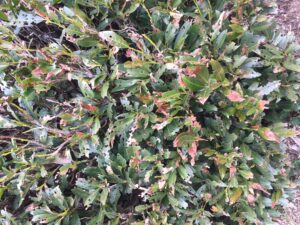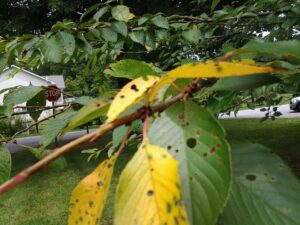Pest Alert – Shothole Disease on Cherries
go.ncsu.edu/readext?935373
en Español / em Português
El inglés es el idioma de control de esta página. En la medida en que haya algún conflicto entre la traducción al inglés y la traducción, el inglés prevalece.
Al hacer clic en el enlace de traducción se activa un servicio de traducción gratuito para convertir la página al español. Al igual que con cualquier traducción por Internet, la conversión no es sensible al contexto y puede que no traduzca el texto en su significado original. NC State Extension no garantiza la exactitud del texto traducido. Por favor, tenga en cuenta que algunas aplicaciones y/o servicios pueden no funcionar como se espera cuando se traducen.
Português
Inglês é o idioma de controle desta página. Na medida que haja algum conflito entre o texto original em Inglês e a tradução, o Inglês prevalece.
Ao clicar no link de tradução, um serviço gratuito de tradução será ativado para converter a página para o Português. Como em qualquer tradução pela internet, a conversão não é sensivel ao contexto e pode não ocorrer a tradução para o significado orginal. O serviço de Extensão da Carolina do Norte (NC State Extension) não garante a exatidão do texto traduzido. Por favor, observe que algumas funções ou serviços podem não funcionar como esperado após a tradução.
English
English is the controlling language of this page. To the extent there is any conflict between the English text and the translation, English controls.
Clicking on the translation link activates a free translation service to convert the page to Spanish. As with any Internet translation, the conversion is not context-sensitive and may not translate the text to its original meaning. NC State Extension does not guarantee the accuracy of the translated text. Please note that some applications and/or services may not function as expected when translated.
Collapse ▲Each year we get questions about holes in the leaves of flowering cherries and cherry laurel. Concerned gardeners find the holes and wonder if an insect is eating their plants. The cause is shot hole disease. Although the holes can make the plants look less than ideal, luckily the disease is harmless to the tree.
The cause of shot hole disease is thought to be a combination of a bacterium and a fungus. This affects plants in the Prunus family including cherries, peaches, plums, cherry laurels, apricots, and nectarines. The holes in the leaves are caused by the leaf spots drying up and falling out. It kind of looks like someone shot the plant with a shotgun.
The good news is that this disease is not harmful to plants. So, there is no need to expose yourself to fungicides. Reducing pesticide use is good for the environment.
If you must use a pesticides, spray appropriate fungicides as soon as new leaves emerge in spring. Continue spraying every 7-10 days until the leaves are fully expanded. Young tender leaves in early spring are the most vulnerable and should be the target of pesticide applications. Fungicides will not get rid of holes in older leaves.







